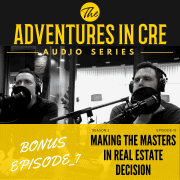Why Manufactured Housing Communities (MHCs) are the safest investment in real estate with Brandt Foster | S3SP10
In this special episode of the A.CRE Audio Series, we feature Brandt Foster, Director at Northwestern Mutual Real Estate, one of the largest institutional real estate investors in the nation. In this conversation, Brandt discusses all the various subtypes that are part of the manufactured housing community (MHC) asset class and details how it has become such a strong performer over recent decades.
We realize that MHC is an investment type that many of our readers may not be very familiar with. Take advantage of this opportunity to learn from the expertise of a seasoned CRE professional in Brandt, who has been an instrumental part of a team with deep experience investing in this unique and interesting asset class!
Why Manufactured Housing Communities (MHCs) are the safest investment in CRE
Or Listen to this Episode
Resources from this Episode
Episode Transcript
Announcer (00:01):
Welcome to The Adventures in CRE Audio Series. Join Michael Belasco and Spencer Burton as they pull back the curtain on everything commercial real estate, and introduce you to some of the top minds in the industry. If you want to take your skills to the next level and be part of a growing community of CRE professionals across the world, this is for you.
Sam Carlson (00:23):
Hello, and welcome back to The Adventures in CRE Audio Series. My name is Sam Carlson. Normally I will kind of frame out the conversation and introduce the guests, but I’m actually going to dip it over to Spencer. He’s going to introduce, tell us what we’re talking about, and we’ll take it from there.
Spencer Burton (00:40):
Yeah. I’m really excited for our guest today, Brandt Foster. Brandt’s a former colleague of mine, and it’s one of the reasons I was so excited to have him on the podcast. This is a rarity for us. So first off, intro for Brandt. Brandt’s 16, 17 years on the institutional side of commercial real estate, 12 years as a director of real estate at one of the largest real estate investment firms in the country, Northwestern Mutual Real Estate. But the primary reason we brought Brandt on, and this is really fascinating for me, is Brandt and his predecessor, the individual who trained Brandt, they are some of the foremost experts on manufactured housing, the investment in manufactured housing communities across the country, have put out I’m guessing some of the largest dollar amounts into the space of really anyone in the country.
Spencer Burton (01:39):
And so Brandt brings a perspective into a niche of real estate that is far deeper than most people we ever bring on the podcast. So Brandt, thank you so much for your time. I know you’re busy. You’re Atlanta based. Great to have you on.
Brandt Foster (01:56):
That’s right. Thank you. Thank you. Appreciate it and looking forward to this.
Spencer Burton (02:03):
Sure. So let’s start. What is MHC? I’m going to be using that throughout the podcast. When I say MHC, what does that encompass? When you’re looking at investments, what would you classify as an MHC investment?
Brandt Foster (02:18):
Yeah. I’d say, well, first off, the acronym is manufactured housing community. And within, from an institutional perspective, I guess you could say that means there are multiple different tiers of property types that sit within that. There are manufactured housing communities, pure MH communities, and I don’t know how detailed your listeners understand the space, so maybe I could kind of explain it high level. But essentially, the owner of the community would own the dirt, the land, and then all the individual homeowners would own their own homes and pay what effectively is land rent, lot rent.
Brandt Foster (03:09):
And that’s why the dynamic is so interesting and obviously has become such a popular property type, is because of that dynamic. So your cash flow payments as your owner of MH, or MHC, is so secure. Now there are different tiers, and that’s kind of what I was alluding to earlier. You’ve got the strongest and most what I would consider institutional caliber slice is 55 plus, so that’s your senior manufactured housing communities. Characteristics of those are, generally speaking, they’re all going to be, I would say 90% of this slice of the pie exists in Florida, California, Arizona, a little bit in places like South Carolina, Texas, Nevada, and then Oregon and Washington, so that’s the bulk of your 55 plus assets sit in those regions.
Brandt Foster (04:16):
You’ve got some real nice stuff in the Northeast and in the Midwest in certain pockets, but geographically, that’s where most of it sits. And then the dynamic there is most of these are obviously retirees, and most of them buy their homes with cash. So a lot of them, this is either a second home, or John Jacobs, who is my predecessor and mentor in the space, always basically gave the example of John and Sue in Detroit retires after 40 years at the Ford plant, moves down to Venice, Florida, buys an MH home for $50,000 cash, and that’s their retirement. And that is kind of your core renter, so it’s obviously a … Within the various communities, you have different tiers of economic strength and household incomes, but that’s kind of the core example of 55 plus. I’ve touched on a lot there.
Spencer Burton (05:23):
Let me stop you for a second. This is the attractiveness of this investment. So let’s take, I think Bob and Sue was Brandt’s example, coming down from Detroit, spending $50,000 of their retirement dollars to buy a new manufactured home. That home is put on a lot. That lot is owned by investors such as Brandt. Bob and Sue pay, say $1000 in lot rent for the privilege of placing their home that they own on that lot. And what’s interesting, if you think about the economics, the waterfall of decisions that go into what a household pays first and second and third when times get tough, if you’re Bob and Sue, and you have a $50,000 investment in a manufactured home, the first thing you’re going to pay is that lot rent because you don’t want to lose your $50,000 investment.
Spencer Burton (06:23):
And that’s in contrast to if I hold an FHA loan, and I loan 97% to Bob and Sue, who go buy a house in Florida, and their mortgage is X, they only lose the 3% down payment. Right? And their credit gets hurt and all those other things. But this lot rent, it is so incredibly safe. I cannot think of in real estate a safer investment, a safer position to be in than Brandt’s in. So you described, call it the traditional MHC home on the lot, lessor owns the lot, Lessee owns the home. You described the over 55. How do you differentiate between those over 55 communities and, say, all age? How does the risk increase with the all-age?
Brandt Foster (07:14):
Right. Just to back up real quick, a big metric and exactly summarizes how you described it is, let’s say just for simplicity of math the home was $60,000 on average and the lot rent was $500. So the way I think of it, or the way a lot of folks think about it is, you essentially have five years of rent payments in equity protecting your collateral. As long as those residents have equity in place above the dirt, your rent is virtually certain. And we can get into the rent growth dynamics, but essentially the way to think about this property type is it’s a perfect inflation hedge. The way that all the leases are structured is it goes with CPI. And oftentimes, it’s more than CPI. It’s CPI plus one, plus two, plus three.
Brandt Foster (08:10):
So right now in this environment when you’re seeing these monster CPI numbers, apartment rent growth comes into question. Obviously, with all the other property types, you’re starting to dial back your rent growth assumptions. But in MH you’re like, “Well, per the letter of our lease, we’re obligated to go up by CPI.” Now not all owners will do that. Some will probably back off to make it less painful and be good owners. So that’s another tremendous dynamic.
Spencer Burton (08:43):
Interesting. Yeah, the inflation hedge is fascinating here.
Brandt Foster (08:47):
Yeah.
Spencer Burton (08:48):
So what about all-age? How do you look at all-age versus the over-55?
Brandt Foster (08:53):
Yeah. So all age is … And again, they run the gamut in terms of quality. You could have an all-age in California, which behaves and looks very similar to 55 plus in Florida or other areas because in California, the housing costs are so dramatically higher than anywhere else, and it’s still such an incredible value proposition. So you could own a, let’s just say a $150,000 or $200,000 manufactured home next to a residential neighborhood with million-dollar homes. And so you can see the value proposition. Same dynamics if your rent’s $1000, incredible amount of equity protecting your rent. So that would be the top crust all age aspect, and then it cascades down the scale.
Brandt Foster (09:45):
The homes are generally going to be worth less. The all-age geography is spread much further throughout the United States. And then you’re much more reliant on the economy at that level because it behaves more like an apartment. You’ve still got some equity, but you do you have loans, so there’s less equity than the 55-plus place. And they’re all reliant on their current incomes and jobs, where the 55 plus, they’re all retired. They’re getting social security, pensions, whatever it may be. So it’s just a less certain cashflow stream. Does that make sense?
Spencer Burton (10:31):
So that’s, let’s call it traditional MHC.
Brandt Foster (10:35):
Yes.
Spencer Burton (10:37):
What are some of the kinds of variations in MHC? RV parks, I’ve seen underwritten before. Are there any others? And can you talk us through some of those others?
Brandt Foster (10:47):
So then below, I say below just to mentally think about it, you would have RV parks. So I think the three categories of MH in my mind are 55 plus, all age, and now what I would just kind of catch-all category, I would call RV parks. And RV parks are what they sound, but within them, there are lots and lots of different tiers of rental stalls and types of parks. So the way I would break it down is, well, really there’s a thing called park models, which are essentially small manufactured homes. So all the dynamics that we just talked about translate here, except the homes are less than usually 1000 square feet, which sounds small, but almost all of these are located in Arizona, Florida, California, so they put on big sunrooms, big patios, and it feels like a nice little home, perfect for retirees.
Brandt Foster (11:53):
And same dynamics, they owe annual lot rent. And there’s no financing or very little financing for park models, so that’s all equity. So instead of that $50,000, maybe you’re 30 or 25, so you can kind of see it’s a little bit lower values, and then but very certain in a strong cashflow stream. Then below that, you’ve got what I’ll call really the core RV component of these parks. And you have really three different tiers. You’ve got annual renters, so think about in Arizona, some of these parks are so popular, there are waiting lists for years to get a spot in some of these parks.
Brandt Foster (12:47):
And so Betty and Joe, who don’t buy a mobile home, they buy an RV, sign up, and basically have the rights to a stall in Arizona. And that’s guaranteed rent. So every year, they’re going to show up to that same stall and park their RV. Or what’s happened is they’ll leave their RV there all year, and they’ll just … They don’t really drive their RV. They’ll just show up and live in their RV. So those would be your best, your most regular tier of income streams is what I would call annual. And in the industry, people may call this stuff different. This is just mentally how I assign things.
Brandt Foster (13:32):
But then you’ll have a similar tier called seasonal, and so these would be folks that come down, your snowbirds that would come down from January to April or May, and same kind of dynamic, but your rent’s going to be higher. So you’re going to pay more in rent to not pay the full 12 months, and it might end up being pretty similar to the annual level. But again, that RV is literally driving in and driving out in the summer months. So you could do an aerial, it’s kind of cool. You can look in … Go to Phoenix, the Phoenix MSA.
Brandt Foster (14:14):
You obviously go over to the East Valley and change the months, so look at an aerial in January through March and you’ll see all the rooftops, all the RVs. They’ll be full. And then change it to August or July, and you could kind of visually see the movement of the literally your income streams from satellite, so it’s kind of a cool thing to check out. And then the last tier would be pure transient. So that’s purely coming for two weeks, coming for a weekend, in and out, much higher per day rental rates, but obviously much more vacancy and volatility with that tier.
Spencer Burton (15:00):
Yeah. That’s interesting about kind of the aerial in Arizona of seeing in real-time how that shifts. You can then understand how your risk is greater, there’s more volatility in the RV versus the 55 plus MHC. That makes a lot of sense. Let’s talk about trends in this space. So look, everyone’s been on TikTok and Instagram and YouTube, and we all see the people who are living out of their vans or whatever. In the institutional side when you have an RV park, how much of this market is that versus how much of this market are the types of people you described, the over 55, the steady? And are you seeing any change because of that trend around a more nomadic world for some of the younger generation?
Brandt Foster (15:51):
I would say the big institutions and all the big players that have entered the space in the last five years are largely focused on the 55 plus, the all age space, and these really premier RV parks with a heavy amount of park model and annuals. I would say the last three years, that’s definitely in terms of cap rates, let’s call it 100 basis, maybe 75 to 100 basis point spread between 55 plus and all age, and then probably 200 plus between RV and 55 plus, so that’s kind of the gamut.
Brandt Foster (16:40):
What we’ve seen is the last three years is that definitely compressed, so now you’re 50 points, maybe 25 points, between 55 plus and all age, and maybe 75 to 100 with RV, so that just tells me right there that a lot of money has moved into that RV space, which inherently has a lot of transient components to it, which is kind of what you’re referencing.
Spencer Burton (17:04):
Yeah. And I’m glad you said that because that was kind of where I wanted to go next, the profile, at least from the institutional standpoint of these investments. What’s the cap rate range? You gave us the spread between kind of different risk profiles. But in today’s … We’re middle of 2022, I know cap rates have softened a bit over the last few months as mortgage rates have risen dramatically. Where are cap rates across this gamut of risk? I mean, are you buying the over 55 at a four-and-a-half cap? So talk us through cap rates. Talk us through typical deal sizes, how many lots, how many … What’s the dollar size? Kind of talk us through the profile of one of these investments.
Brandt Foster (17:45):
Yeah, sure. I’ll kind of set the stage. What’s happened, so I started in the space in 2010. And what was kind of funny, and I chuckle now, a lot of my peers were getting assigned the malls, regional malls, office towers, et cetera. And I got assigned to manufactured housing. And I was like, “Well, all right. Whatever. I’ll learn it, understand it.” And it turned … Fortuitously, now it’s probably the lowest cap rate property type, even in a lot of instances up to 50 points inside of class A multifamily.
Brandt Foster (18:31):
And so what’s happened is what used to be largely mom-and-pop ownerships, very fragmented ownerships, where you’d have hundreds of owners of these really top quality, top-notch assets, has basically been gobbled up piece by piece, and chunk by chunk, by all the big players in the space. And so now in Florida, for example, 10 years ago, there might have been upwards of 150 class A assets that were owned by various families, individuals, small operators. Today, there might be 20 left.
Spencer Burton (19:17):
Wow.
Brandt Foster (19:17):
And you can be certain that of those 20, every single acquisition player at every single shop has them on a first-name basis and is trying to buy them eventually. So you’ve seen cap rates, which it’s mirrored apartments, the compression, but I would say in the last … And I would say it’s gone so that the top tier, the absolute best in class stuff is trading well into the threes. And it’s stayed pretty steady because of that inflation factor that I talked about where on apartments, your rent grown assumptions, yeah, you’re driving them sky high, but here, it’s … I guess if you’re getting leverage at let’s just say a 5% rate, you’re going to be very certain that in this year, you’re going to get 8%, 9% rent growth.
Brandt Foster (20:23):
So you might be buying at a three cap, but in a couple years you’re going to be positive on leverage, so it hasn’t really moved cap rates. And there’s so much depth and so much hunger for the space that cap rates have stayed pretty steady. Inevitably, I think we’ll see a little bit of that backing off, but not too much yet. So was that a good description?
Spencer Burton (20:52):
That’s a great description of it. The inflation hedge makes sense that you wouldn’t see an expansion in cap rates in this space as much as you might say in a credit-backed lease, lease to Amazon with 2% annual bumps, or even more so, what I spent a lot of time on in the last couple years, in single tenant retail, where there are no bumps. Walgreens for instance has no bumps in a 60-year lease. And so you would expect with that sort of lease you’re going to have a fairly large expansion in cap rates to account for inflation. And what you’re describing is a scenario where cap rates can hold because you’re protected entirely through a CPI bump in the lease, so that’s fascinating. We’re running out of time. I want to be sensitive to you, but let me ask this.
Brandt Foster (21:40):
Think about-
Spencer Burton (21:43):
Go ahead.
Brandt Foster (21:45):
I was just going to add, so yeah, you’ve got all the US institutional investors. I reference it as New York money. But in addition, now you’ve got international pension funds and sovereign wealth funds that understand the dynamics, and that US … Basically, it’s a bond. It’s as close as you can get to a bond, but with equity characteristics. And it’s hyper-attractive in these other low-interest rate economies across the world, so a lot of foreign money has entered the space as well.
Spencer Burton (22:22):
Yeah. And that institutional capital, as you described, is going out and really gobbling up, consolidating, in the same way that all these small banks were consolidated in the ’90s. I remember when I was a kid, there were a million banks, and then there were a handful of major banks that consolidated most of the banks. Really, that’s happening. How about new supply though? And this is where I want to finish. There are developers of space, but what I’ve been told is that there are significant barriers to getting this product approved in the market. Talk to us about supply opportunities. And for our listeners who maybe have an interest in developing this sort of product, what sort of opportunities exist there?
Brandt Foster (23:06):
Yeah. That’s always been the other benefit against, call it apartments for example, is because it’s incredibly difficult to build new supply, especially at the 55 plus and all age tier. RV parks are a little easier because you’re literally laying concrete, electric hookups, and utilities, and you can do that on a pretty efficient scale. To build an MH park, one, you’ve got to get it zoned. And because there’s a lot of misunderstanding about the quality of the property types out there, there’s a lot of NIMBYism, really hard to get them zoned. I think this could be folklore, but up until recently, I don’t think there hadn’t been a park in California developed since the early ’90s.
Brandt Foster (24:05):
So think about that, zero new supply. But then above and beyond that, let’s say you could get it zoned on the best corner in town. You’ve got to then buy the land, which is going to be expensive. Then you’ve got to invest upwards of, which geez, three or four years ago it was $35,000, $40,000 in infrastructure costs, it’s probably $60,000 to $65,000 today, upfront, before you even get a drop of income. So you’re building roads, sewers, utility hookups, everything. You’re going to build an amenity package. And so that’s a heavy, heavy, heavy upfront investment.
Brandt Foster (24:44):
Then you have to have a marketing and sales program much like a single-family home community. You have to get 300, and I say 300 because 300 lots is kind of the core type of a community, 200 to 300 is in that ballpark. You’ve got to get 300 people to come and buy homes, invest … When I referenced $50,000 earlier, that’s a resale. That’s an old home from the ’80s, ’90s, ’70s in some instances. New homes are $120,000 to $150,000. So you’ve got to have 300 people willing to pay $150,000 and largely with all cash. There is a little bit of financing out there. So that can take years and years to lease up.
Brandt Foster (25:36):
I think in the heyday of MH development, which was probably in the mid-2000s, probably 2000 to 2006, you’d see a lot of parks in Florida that would go 50, 60, to 100 homes a year. And so they were just cranking them out. And these days, to envision … There may be a few like that, but that would be exceedingly rare. So if you’re going to underwrite that, the most you could realistically underwrite is 25 to 35 a year. And that’s pretty aggressive. Times like right now, that might come to a grinding halt pretty quick, so that’s kind of the development dynamics. But if you can figure it out and you can do, what I would say, is phases.
Brandt Foster (26:23):
So maybe get a little piece of land, you want to put 70 or 50 lots. You could maybe do a road and do the first 12, and just kind of stagger your capital investment. That’s how you could, a smaller investor could feasibly build one of these things out. But to do an institutional caliber one would be extremely rare. That just tells you how rare it is, because nobody can really do it. The only way you can do it is if you have a piece of extra land tied to your existing community, and you’ve got tons of cashflow, and you can start fronting the cap X on the other phases.
Spencer Burton (27:01):
That’s fascinating.
Brandt Foster (27:03):
Pretty good supply side.
Spencer Burton (27:07):
Yeah, yeah. I mean, it’s a strong demand with as good of credit protection as you’ll ever find. You have the CPI bumps. And then you’ve got these significant barriers to new supply. It is the quintessential ideal investment. And to a comment you made earlier, there’d been a stigma for a lot of years around MHC. And a lot of investors steer clear because of what you were describing, but the secret’s out. Thanks, Brandt, for your time.
Brandt Foster (27:40):
And I’ll say, Spencer-
Spencer Burton (27:41):
As I said in the beginning-
Brandt Foster (27:44):
Sorry to interrupt. The ones that I’m referencing, if you were to walk through them or drive through them, you would have no idea it wasn’t a single-family residential community. I mean, there are so many incredibly nice ones. I always joke with my wife like, “Hey, we could have a place in Phoenix and a place in Sarasota. We could live in an MH park.” So maybe we’ll get there someday.
Spencer Burton (28:11):
I’m envisioning Brandt in his retirement. He’s got his three MHC homes around the country. I love it. Well, thanks again for your time. Yeah. I know you’re busy. And for the listeners who perhaps want to reach out to Brandt, we’ll make sure to include his LinkedIn profile in the description. So with that, let me turn it back to Sam to wrap us up.
Sam Carlson (28:29):
Yeah, Brandt, thank you so much. So for the listeners, thanks for listening and we’ll see you on the next podcast.
Announcer (28:34):
Thanks for tuning in to this episode of The Adventures in CRE Audio Series. For show notes and additional resources, head over to www.adventruesincre.com/audioseries. Would you like to learn real estate financial modeling in a matter of weeks and do it with zero guesswork? If so, the A.CRE Accelerator is for you. The accelerator is a step-by-step, case-based program designed to teach you exactly what you need to know and in the order you need to know it, so you can gain both the knowledge and experience to take your career to the next level. To see if the accelerator is right for you, go to www.adventuresincre.com/accelerator.








